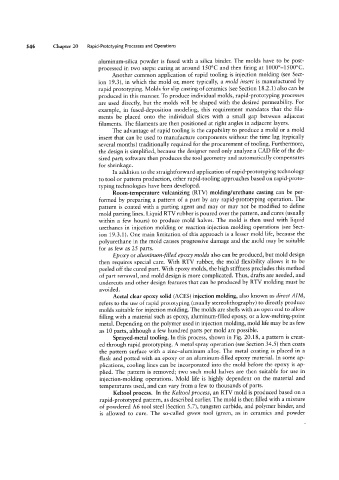Page 566 - 04. Subyek Engineering Materials - Manufacturing, Engineering and Technology SI 6th Edition - Serope Kalpakjian, Stephen Schmid (2009)
P. 566
Chapter 20 Rapnd-Prototyping Processes and Operations
aluminum-silica powder is fused with a silica binder. The molds have to be post-
processed in two steps: curing at around 150°C and then firing at 1000°-1500°C.
Another common application of rapid tooling is injection molding (see Sect-
ion 19.3), in which the mold or, more typically, a mold insert is manufactured by
rapid prototyping. Molds for slip casting of ceramics (see Section 18.2.1) also can be
produced in this manner. To produce individual molds, rapid-prototyping processes
are used directly, but the molds will be shaped with the desired permeability. For
example, in fused-deposition modeling, this requirement mandates that the fila-
ments be placed onto the individual slices with a small gap between adjacent
filaments. The filaments are then positioned at right angles in adjacent layers.
The advantage of rapid tooling is the capability to produce a mold or a mold
insert that can be used to manufacture components without the time lag (typically
several months) traditionally required for the procurement of tooling. Furthermore,
the design is simplified, because the designer need only analyze a CAD file of the de-
sired part; software then produces the tool geometry and automatically compensates
for shrinkage.
In addition to the straightforward application of rapid-prototyping technology
to tool or pattern production, other rapid-tooling approaches based on rapid-proto-
typing technologies have been developed.
Room-temperature vulcanizing (RTV) molding/urethane casting can be per-
formed by preparing a pattern of a part by any rapid-prototyping operation. The
pattern is coated with a parting agent and may or may not be modified to define
mold parting lines. Liquid RTV rubber is poured over the pattern, and cures (usually
within a few hours) to produce mold halves. The mold is then used with liquid
urethanes in injection molding or reaction-injection molding operations (see Sect-
ion 19.3.1). One main limitation of this approach is a lesser mold life, because the
polyurethane in the mold causes progressive damage and the mold may be suitable
for as few as 25 parts.
Epoxy or aluminum-filled epoxy molds also can be produced, but mold design
then requires special care. With RTV rubber, the mold flexibility allows it to be
peeled off the cured part. With epoxy molds, the high stiffness precludes this method
of part removal, and mold design is more complicated. Thus, drafts are needed, and
undercuts and other design features that can be produced by RTV molding must be
avoided.
Acetal clear epoxy solid (ACES) injection molding, also known as direct AIM,
refers to the use of rapid prototyping (usually stereolithography) to directly produce
molds suitable for injection molding. The molds are shells with an open end to allow
filling with a material such as epoxy, aluminum-filled epoxy, or a low-melting-point
metal. Depending on the polymer used in injection molding, mold life may be as few
as 10 parts, although a few hundred parts per mold are possible.
Sprayed-metal tooling. In this process, shown in Fig. 20.18, a pattern is creat-
ed through rapid prototyping. A metal spray operation (see Section 34.5) then coats
the pattern surface with a zinc-aluminum alloy. The metal coating is placed in a
flask and potted with an epoxy or an aluminum-filled epoxy material. In some ap-
plications, cooling lines can be incorporated into the mold before the epoxy is ap-
plied. The pattern is removed; two such mold halves are then suitable for use in
injection-molding operations. Mold life is highly dependent on the material and
temperatures used, and can vary from a few to thousands of parts.
Keltool process. In the Keltool process, an RTV mold is produced based on a
rapid-prototyped pattern, as described earlier. The mold is then filled with a mixture
of powdered A6 tool steel (Section 5.7), tungsten carbide, and polymer binder, and
is allowed to cure. The so-called green tool (green, as in ceramics and powder

